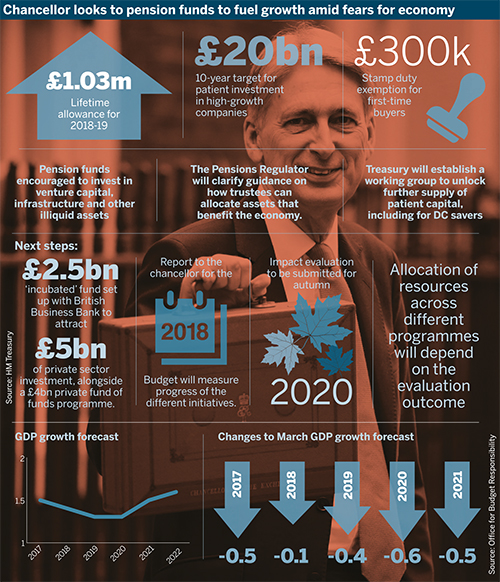Autumn Budget 2017: Chancellor of the exchequer Philip Hammond stated the government’s desire to see pension funds invest in patient capital as part of its Autumn Budget.
The move follows a government consultation on lowering barriers to patient capital investment that closed in September 2017.
The paper examined avenues towards facilitating long-term illiquid investments in start-up companies for defined benefit and defined contribution schemes.
The Pensions Regulator will provide guidance on how trustees can increase patient capital investment. Neither the regulator nor HM Treasury could confirm a timescale on this guidance.
We don’t get much engagement with the investments, so this might be a great figure for getting the young savers engaged in the investment process
Dinesh Visavadia, Independent Trustee Services
The Treasury will establish a working group consisting of institutional investors and fund managers with the aim of increasing access to patient capital for innovative firms, and removing barriers to investment for DC members.
Daily pricing an problem for patient capital in DC
In a Budget that surprised few in its paucity of pensions detail, the chancellor revived a challenge that dates as far back as the Myners report in 2001, which investigated early-stage institutional investment in the UK.
Laura Myers, head of DC investment at consultancy LCP, said pricing illiquid assets was an obstacle for DC funds looking to invest in patient capital.
“Currently you have a system set up where you’ve got platforms [and] administrators of DC schemes requiring daily pricing and in most cases, daily trading,” she said.

“Consequently, if you have an asset that is illiquid and doesn’t get priced frequently, you tend to have a mismatch there with members being able to sell in and out of their DC pensions on a daily basis but not getting an actual price for those underlying assets,” she added.
Myers called for investment into the infrastructure of platforms and administrators as a means of facilitating investment in illiquid assets.
“You can get over the pricing issue, you do it already on property funds… but a lot of platforms just refuse to hold illiquid assets on them,” she said.
Could opt-in requirements be the answer?
In a Treasury paper laying out the response to the government’s consultation, the introduction of an “opt-in” requirement on new payments into DC pension schemes was mooted.
In France, reforms in 2008 led to corporate employee savings schemes offering a “Solidarity Investment Funds” option. The amount of capital allocated to Solidarity Investment Funds grew from €200m (£177.5m) in 2002 to €6bn in 2016.
Steve Webb, former pensions minister and director of policy at Royal London, was sceptical about the potential success of an opt-in requirement.
“We know the power of defaults, the power of inertia,” he said. “If people really, really want to be able to move their pension money into this new category, great, they’ll be able to,” he said.
“But if people are desperate to do that sort of thing they could [move] into some other forms of investment where they could choose this sort of thing anyway,” he added.
Several respondents to the government consultation suggested mandatory targets for pension funds to allocate a portion of their assets towards patient capital. Webb doubted the feasibility of this idea.
“You’ve got to think about the age mix of your pension members… if you’re investing for a shorter time horizon because you’ve got older members in your pension scheme, being told to invest in long-term patient [capital] would potentially create volatility,” he said.
Capitalise on young savers
The answer to raising patient capital investment from schemes may lie with younger members with enthusiasm for the fruits of patient capital.
The consultation cited a Department for Work and Pensions green paper in 2017, which called into question whether a conservative interpretation of trustees’ responsibilities, coupled with the increasing maturity of schemes, is contributing to a “sub-optimal allocation of assets”.
Patient capital consultation met with industry scepticism
The government ran a consultation on financing growth in innovative firms earlier this year, as it looks to increase scheme investment in ‘patient capital’, but concerns persist over the suitability of this asset class for pension schemes.
Dinesh Visavadia, director at Independent Trustee Services, was in favour of schemes investing in patient capital. He recognised, however, that other trustees view patient capital as “quite far out on the risk spectrum”.
“I think it’s just the nature of trustees… they’re pretty conservative in my opinion,” he said. “I can see the economic benefit of this and the alignment of interest,” he added.
Investment in patient capital represents an opportunity to engage with younger members, according to Visavadia.
“We don’t get much engagement with the investments, so this might be a great figure for getting the young savers engaged in the investment process,” he said.
“The young savers have a different mindset in terms of how they save for their pensions and retirement,” he added.














